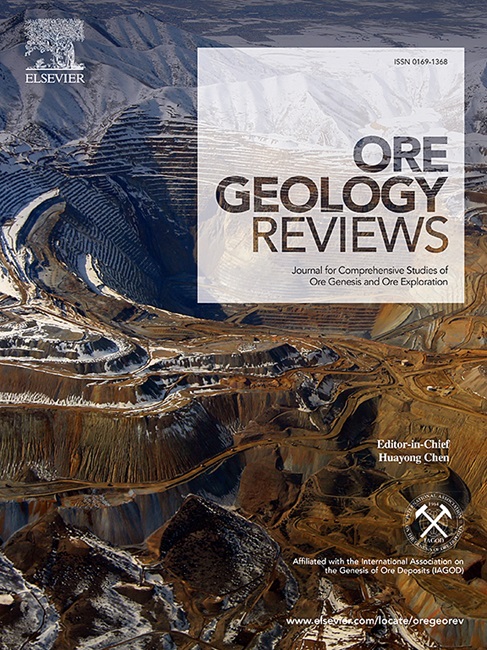东秦岭小南沟金矿白色云母的短波红外光谱及地球化学特征:作为高光谱勘查工具
IF 3.6
2区 地球科学
Q1 GEOLOGY
引用次数: 0
摘要
小秦岭-熊耳山地区是东秦岭带的重要组成部分,以其钼矿和金矿闻名于世。此外,这里的黄金储量至少有 1300 吨,是中国仅次于胶东的黄金开采大省。小南沟金矿床位于熊耳山地区的东部中心,金储量估计超过 60 吨,其特点是在蚀变岩中呈浸染状分布。根据详细的岩石学调查,结合横切关系分析,热液蚀变和成矿作用分为三个阶段:前矿K长石+石英(Ⅰ阶段)、矿石石英+闪长岩+浸染状黄铁矿+多金属硫化物(Ⅱ阶段)和后矿石石英+碳酸盐(Ⅲ阶段)。通过对短波红外光谱的系统分析发现,蚀变矿物主要有四种类型,包括白云母、粘土矿物、绿泥石和碳酸盐矿物。在矿体中,白云母主要发育于Ⅱ期,Ⅰ期略有发生。粘土矿物和绿泥石通常发育在矿体外的带状蚀变带中。大部分碳酸盐矿物,包括方解石和白云石,主要发育在Ⅲ阶段,但在Ⅱ阶段,方解石与黄铁矿、石英和多金属硫化物伴生。其中,白云母被认为是最丰富的热液蚀变矿物,在小南沟金矿床蚀变带中广泛分布。白云母的 SWIR 参数及其空间变化表明,在矿体附近,Al-OH 吸收位置(Pos2200)呈现出向长波长(2205 nm)漂移的趋势。此外,同一区域的伊利石结晶度(IC 值)也有明显增加。相关流体的温度、氧化还原和酸碱度条件可以通过这些参数的特征描述反映出来。此外,它还表明小南沟金矿床的近矿带处于相对氧化、碱性和高温环境中。根据电子探针显微分析(EPMA)结果,白云母中存在两种不同的末端成员:一种是贫硅、富铝的白云母,另一种是贫铝、富含硅、铁和镁的辉绿岩。Si、ivAl、viAl、Mg、Fe 和 Ti 元素与 Pos2200 波长呈线性相关,表明白云母波长的变化主要受 Tschermak 替代(ivSivi(Mg,Fe)↔ivAlviAl)的控制。应用白云母的西南红外光谱参数的空间变化和地球化学性质,有助于有效指导矿产勘探。与其他矿床相比,可以得出结论:Pos2200 波长较长(2205 nm),白云母 IC 值较高(1.4),可作为小南沟金矿床金矿化的有效矢量。本文章由计算机程序翻译,如有差异,请以英文原文为准。

Short wavelength infrared (SWIR) spectral and geochemical characteristics of white micas in the Xiaonangou gold deposit, East Qinling: As a hyperspectral tool in exploration
The Xiaoqinling-Xiong’ershan region, a prominent component of the East Qinling Belt, is renowned worldwide for its molybdenum and gold ore fields. Moreover, with gold reserves of at least 1300 tons, it is also China’s major gold mining province, second only to Jiaodong. Seated in eastern center of the Xiong’ershan area, the Xiaonangou gold deposit has an estimated gold reserve of over 60 tons and is characterized by disseminated gold in altered rocks. Based on detailed petrographic investigation, coupled with an analysis of crosscutting relationships, there are three stages of hydrothermal alteration and mineralization: pre-ore K-feldspar + quartz (stage Ⅰ), ore quartz + ankerite + disseminated pyrite + polymetallic sulfide (stage Ⅱ), and post-ore quartz + carbonate (stage Ⅲ). As revealed by a systematic analysis of short wavelength infrared (SWIR) spectroscopy, four main types of alteration minerals exist, including white micas, clay minerals, chlorite, and carbonate minerals. In the ore body, white micas mainly developed in stage Ⅱ, and slightly occurred in stage Ⅰ. The clay minerals and chlorite usually developed in the banded alteration zones outside the orebody. Most of the carbonate minerals, including calcite and dolomite, mainly developed in stage Ⅲ, but the ankerite was associated with disseminated pyrite, quartz and polymetallic sulfides in stage Ⅱ. Of these, white micas were recognized as the most abundant hydrothermal alteration minerals, which were observed to be widely distributed within alteration zones in the Xiaonangou gold deposit. The SWIR parameters and its spatial variation of white mica indicate that the Al-OH absorption positions (Pos2200) exhibit a drifting tendency towards longer (>2205 nm) wavelengths in the ore body vicinity. Additionally, there is a discernible increase in illite crystallinity (IC values) in the same region. The temperature, redox, and pH conditions for associated fluids can be reflected through characterization of these parameters. Furthermore, it demonstrates that the ore-proximal zones are situated in a relatively oxidized, alkaline, and high-temperature environment in the Xiaonangou gold deposit. According to the electron probe microanalysis (EPMA) results, two distinct end members exist in white mica: a Si-poor, Al-rich muscovite and an Al-poor, Si-, Fe-, and Mg-rich phengite. The Si, ivAl, viAl, Mg, Fe, and Ti elements exhibit a linear correlation with the wavelength of Pos2200, demonstrating that the shift in wavelength of white mica is predominantly controlled by Tschermak substitution (ivSivi(Mg,Fe) ↔ivAlviAl). The application of spatial variation in the SWIR spectral parameters along with geochemical properties of white mica facilitates the effective guidance of mineral exploration. In comparison to other deposits, it can be concluded that the longer (>2205 nm) wavelength of the Pos2200 along with the higher IC values (>1.4) of white mica are applicable as valid vectors towards gold mineralization in the Xiaonangou gold deposit.
求助全文
通过发布文献求助,成功后即可免费获取论文全文。
去求助
来源期刊

Ore Geology Reviews
地学-地质学
CiteScore
6.50
自引率
27.30%
发文量
546
审稿时长
22.9 weeks
期刊介绍:
Ore Geology Reviews aims to familiarize all earth scientists with recent advances in a number of interconnected disciplines related to the study of, and search for, ore deposits. The reviews range from brief to longer contributions, but the journal preferentially publishes manuscripts that fill the niche between the commonly shorter journal articles and the comprehensive book coverages, and thus has a special appeal to many authors and readers.
 求助内容:
求助内容: 应助结果提醒方式:
应助结果提醒方式:


